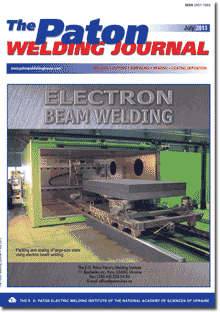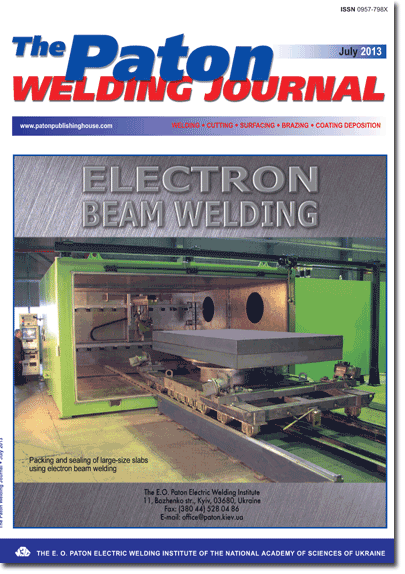| 2013 №07 (04) | 2013 №07 (06) |

The Paton Welding Journal, 2013, #7, 31-38 pages
MELTING OF ELECTRODE AND BASE METAL IN ELECTROSLAG WELDING
B.E. PATON1, I.I. LYCHKO1, K.A. YUSHCHENKO1, S.A. SUPRUN1, S.M. KOZULIN1 and A.A. KLIMENKO2
1E.O. Paton Electric Welding Institute, NASU. 11 Bozhenko Str., 03680, Kiev, Ukraine. E-mail: office@paton.kiev.ua
2Company «M.V. Frunze Sumy NPO». 58 Gorky Str., 40004, Sumy, Ukraine. E-mail: klimenko_@frunze.com.ua
Abstract
The present article is devoted to the problems of study of physical nature of electroslag welding using development of new methods and application of existing ones for investigations of processes of fusion welding. The results of study of electroslag welding process by wire electrode were given using method of direct visual observations through the optically transparent medium of phenomena running in the welding space and further shot-by-shot processing of materials of rapid filming. The analysis was given and description of some phenomena observed in the selected basic cell of welding space: melting of slag and electrode, formation of central nugget of an interelectrode gap in the form of slag-metal-gas plasma-type discharge, evolution of heat power and its dissemination in welding space and also numerous sizes of its basic geometric parameters. The obtained detailed conceptions about the physical nature of electroslag process allow more efficient using of its advantages in the development of new technologies and equipment for manufacture of thick-sheet massive welded metal structures. 28 Ref., 1 Table, 7 Figures.
Keywords: electroslag welding, welding space, slag pool, interelectrode gap, maximum temperature zone, active zone, interelectrode gap nugget, slag-metal-gas plasma-type discharge, melting and transfer of molten metal, weld formation, rapid filming and photography
Received: 04.04.13
Published: 28.07.13
References
1. (1959) Electroslag welding. Ed. by B.E. Paton. Kiev: Mashgiz.
2. (1980) Electroslag welding and cladding. Ed. by B.E. Paton. Moscow: Mashinostroenie.
3. Voloshkevich, G.Z. (1951) Method of forced formation and its application. Avtomatich. Svarka, 1, 3-19.
4. Voloshkevich, G.Z. (1953) Electroslag welding. Ibid., 6, 3-10.
5. Gotalsky, Yu.N. (1954) To problem of interaction between slag and metal in electroslag welding. Ibid., 5, 38-43.
6. Paton, B.E. (1955) Automatic control of electroslag welding. Ibid., 3, 39-50.
7. Voloshkevich, G.Z. (1955) X-ray examination of electrode melting and metal transfer. In: Problems of electric arc and resistance welding. Moscow: Mashgiz.
8. Pokhodnya, I.K. (1955) Interaction of slag and metal in arc and electroslag cladding of high-chromium ledeburite steels. Avtomatich. Svarka, 5, 44-46.
9. Dudko, D.A., Rublevsky, I.N. (1956) Some metallurgical specifics of electroslag welding process. Ibid., 4, 22-29.
10. Voloshkevich, G.Z. (1958) About electroslag welding modes. Ibid., 3, 12-17.
11. Podgaetsky, V.V. (1956) About fluxes for electroslag welding. Ibid., 4, 30-49.
12. Voloshkevich, G.Z. (1958) Melting of electrode and metal transfer in electroslag welding. Ibid., 10, 14-21.
13. Dudko, D.A., Rublevsky, I.N. (1958) Influence of current kind and polarity on metallurgical processes in electroslag welding. Ibid., 3, 75-78.
14. Voloshkevich, G.Z. (1961) Temperature field of product in electroslag welding. Ibid., 7, 40-45.
15. Voloshkevich, G.Z. (1962) Stabilization of electroslag welding. Ibid., 4, 1-5.
16. Voloshkevich, G.Z. (1962) Electroslag welding: Report-abstracts of published articles for Dr. of Techn. Sci. Degree assignment. Kiev: AN UkrSSR.
17. Paton, B.E. (1972) New method of electroslag welding. Svarochn. Proizvodstvo, 6, 16-17.
18. Dudko, D.A., Voloshkevich, G.Z., Sushchuk-Slyusarenko, I.I. et al. (1971) Investigation of electroslag process using cine-photo filming through transparent medium. Avtomatich. Svarka, 2, 15-17.
19. Pertsovsky, G.A. (1959) Determination of pool temperature in electroslag process by calorimetric method. In: Welding. Moscow: Sudpromgiz, 156-162.
20. Pugin, A.I., Pertsovsky, G.A. (1963) Calculations of thermal cycle of near-weld zone in electroslag welding. Avtomatich. Svarka, 6, 14-23.
21. Kokh, B.A. (1962) Thermal cycle of electroslag welding. Svarochn. Proizvodstvo, 1, 1-4.
22. Sharapov, Yu.V. (1965) Temperature fields in electroslag welding. Avtomatich. Svarka, 6, 32-37.
23. Sharapov, Yu.V. (1968) To calculation of penetration zone in electroslag welding. Svarochn. Proizvodstvo, 6, 13-15.
24. Medovar, B.I., Tsykulenko, A.K., Bogachenko, A.G. et al. (1982) Electroslag technology abroad. Kiev: Naukova Dumka.
25. Ando, A., Nakata, S., Wada, H. (1970) Studies on the electroslag welding (report 111). J. JWS, 40(11), 1104-1110.
26. Brandi, S.D., Liu, S., Thomas, R.D. (2012) Electroslag and electrogas welding. In: AWS Welding Handbook, Vol. 6A, 365-379.
27. Paton, B., Dudko, D., Yushchenko, K. et al. (1997) Electroslag welding: a status report. Welding J., 12, 51-58.
28. Yushchenko, K.A., Lychko, I.I., Sushchuk-Slyusarenko, I.I. (1999) Effective techniques of electroslag welding and prospects for their application in welding production. In: Welding and Surfacing Rev., Vol.12, Pt 2. Amsterdam: Harwood Acad. Publ.
Suggested Citation
B.E. PATON, I.I. LYCHKO, K.A. YUSHCHENKO, S.A. SUPRUN, S.M. KOZULIN and A.A. KLIMENKO (2013) MELTING OF ELECTRODE AND BASE METAL IN ELECTROSLAG WELDING. The Paton Welding J., 07, 31-38.The cost of subscription/purchase order journals or individual articles
| Journal/Currency | Annual Set | 1 issue printed |
1 issue |
one article |
| TPWJ/USD | 384 $ | 32 $ | 26 $ | 13 $ |
| TPWJ/EUR | 348 € | 29 € | 24 € | 12 € |
| TPWJ/UAH | 7200 UAH | 600 UAH | 600 UAH | 280 UAH |
| AS/UAH | 1800 UAH | 300 UAH | 300 UAH | 150 UAH |
| AS/USD | 192 $ | 32 $ | 26 $ | 13 $ |
| AS/EUR | 180 € | 30 € | 25 € | 12 € |
| SEM/UAH | 1200 UAH | 300 UAH | 300 UAH | 150 UAH |
| SEM/USD | 128 $ | 32 $ | 26 $ | 13 $ |
| SEM/EUR | 120 € | 30 € | 25 € | 12 € |
| TDNK/UAH | 1200 UAH | 300 UAH | 300 UAH | 150 UAH |
| TDNK/USD | 128 $ | 32 $ | 26 $ | 13 $ |
| TDNK/EUR | 120 € | 30 € | 25 € | 15 € |
AS = «Automatic Welding» - 6 issues per year;
TPWJ = «PATON WELDING JOURNAL» - 12 issues per year;
SEM = «Electrometallurgy Today» - 4 issues per year;
TDNK = «Technical Diagnostics and Non-Destructive Testing» - 4 issues per year.


